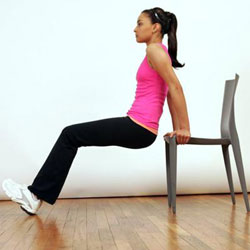Your body has two types of muscle (really more than this, but the others are in your internal organs), movers and stabilizers. Movers are big muscles that move your body parts, hence the name. Stabilizers are muscles that hold your parts in place and prevent you from being damaged while the movers are moving you.

According to the American Council on Exercise, “Stabilizing muscle contractions are generally isometric contractions that act to support the trunk, limit movement in a joint, or control balance.” In other words, muscles acting in a stabilizing role aren’t directly involved in lifting a weight, but instead keep certain parts of the body steady so that the primary working muscles can do their job properly.
Small movements in the spinal or peripheral joints such as the hip or shoulder can cause pain, degeneration and poor biomechanics. Localizing and strengthening the stabilizer muscles helps minimize these harmful joint translations and create a solid body framework.
The three principle stabilizer muscles function at:
- The trunk– The trunk or core consists of a deep stabilizing layer attaching directly to the spine, and a secondary layer which produces spinal movement. The deep layer, transversus/multifidus, is responsible for stabilizing the individual spinal segments. Most individuals with back pain will present with a dysfunction of this important muscle group.
- The hip joint- This proximal joint in the lower limb must be dynamically balanced to permit efficient biomechanical motion in walking and running. The gluteus medius muscle is the stabilizer of the hip joint and specific strengthening of this muscle will help prevent knee injuries and maximize the potential power of quadriceps.
- The shoulder complex- The most mobile joint in the body, the shoulder complex relies heavily on stabilizer function for correct mechanics and injury prevention. The lower trapezius muscle controls the positioning of the shoulder blade providing a platform for the development of power and avoiding injuries to the rotator cuff. Lower trapezius activity also reduces upper trapezius tension, one of the prime causes of neck pain and tension.
Why is it essential to develop Stabilizer Muscles?
There are a few reasons:

- The inability to stabilize the body during strength training may reduce the amount of weight you’re able to use on exercises. For example, the military press exercise directly works the shoulders and triceps. The lower back muscles, though, help stabilize the trunk, and if they’re weak, then the amount of weight you can use on the exercise is reduced – regardless of how strong your shoulders and triceps are. This then reduces the effectiveness of the exercise on the target muscles.
- Athletic movements outside of the weight room depend largely on the ability of the body to stabilize itself. A football lineman throwing a block drives forward with his hips, but if his feet, calves, torso, and shoulder girdle aren’t tight, then the power of his block is vastly reduced. Even everyday activities, like picking up a bulky sack of groceries or walking up steps, requires the body to balance and steady itself, which in turn requires strong stabilization abilities.
- Stabilizing contractions in and of themselves build muscle. Competitive power lifters rarely do direct abdominal flexion work, such as crunches, but they often have very impressive abdominal muscles because they train extensively in the squat and deadlift. Both squatting and dead-lifting put the ab muscles in a stabilizing role rather than a motive role, but nevertheless cause the abs to get stronger and more muscular. Using any of your body’s muscles in a stabilizing capacity can directly result in added muscular size.
Studies of back pain patients show that high percentages of patients with chronic back pain have a different mix of fast vs. slow twitch muscle fibers. Studies also show that those with back pain tend to have very low endurance of their stabilizers – particularly the multifidus. To prevent back pain, you need your stabilizer muscles to have endurance. |
How to Train for Stabilization
There are three ways you can train if you want to increase your body’s stabilization abilities.

-
Perform exercises that sufficiently tense the entire body. Please notice the word “sufficiently.” Practically any exercise will tense your entire body to a degree, but some exercises are particularly effective at causing your entire body to stay tight. For your legs and hips, try squats, deadlifts and weighted lunges instead of leg press and leg extension. The former exercises require the muscles of your back and shoulders to support and steady a barbell, while the latter exercises allow you to shift much of the stabilization responsibility to the seat on which you recline. For similar reasons, pull-ups are better than machine pull-down, dips are better than bench press, and standing military press are better than the seated equivalent.
-
 Incorporate unilateral movements into your workouts. Do exercises with one arm or one leg at a time. Try one-armeddumbbell bench press, one-legged squat, one-armed dumbbell row, and whatever else seems appropriate. One-armed work causes the abdominal obliques and the lower back muscles to fire, to keep the trunk from excessively rotating. One-legged work causes all of the muscles of the planted leg to work in a stabilizing capacity, to help maintain balance.
Incorporate unilateral movements into your workouts. Do exercises with one arm or one leg at a time. Try one-armeddumbbell bench press, one-legged squat, one-armed dumbbell row, and whatever else seems appropriate. One-armed work causes the abdominal obliques and the lower back muscles to fire, to keep the trunk from excessively rotating. One-legged work causes all of the muscles of the planted leg to work in a stabilizing capacity, to help maintain balance. -
Experiment with unstable loads. This is an advanced technique that’s not appropriate for beginners. But some trainees would benefit from lifting unstable loads such as sandbags, kegs and barrels half full of water, and unevenly packed boxes. When lifting unstable loads, as the weight shifts, the muscles have to take on the role of stabilizer, then prime mover, then stabilizer again. This teaches your body to recruit muscles in a stabilizing capacity as rapidly as possible. If you do decide to use this technique, proceed with caution.
Strong stabilizer muscles are essential for maximizing your fitness results. Too often individuals concentrate on exercising the major muscle groups while neglecting stability training. Weak stabilizers will prevent a person from lifting heavy weight even though their major muscles can handle it. Remember, the more stabilizers and synergists worked, the more muscle fibers stimulated.
Disclaimer
The Content is not intended to be a substitute for professional medical advice, diagnosis, or treatment. Always seek the advice of your physician or other qualified health provider with any questions you may have regarding a medical condition.



